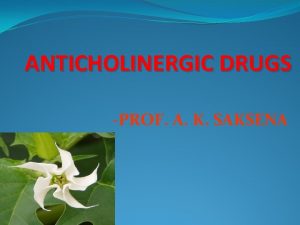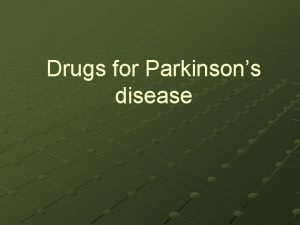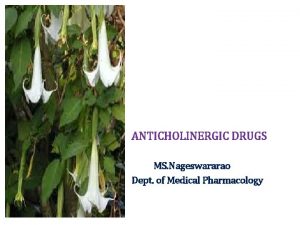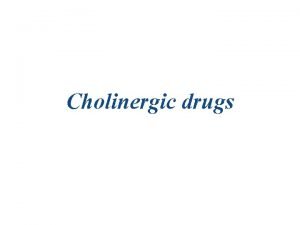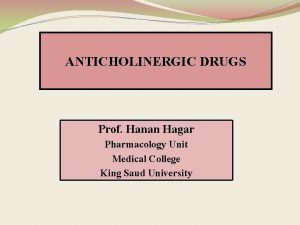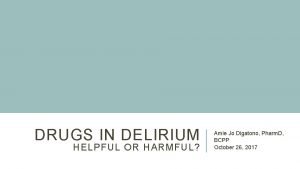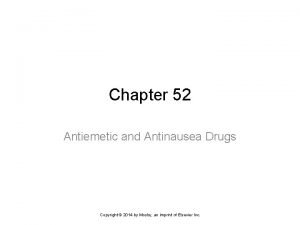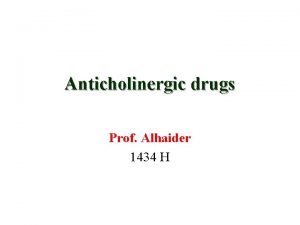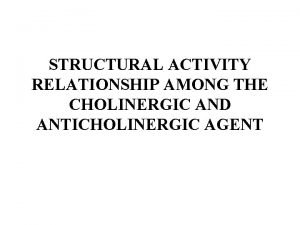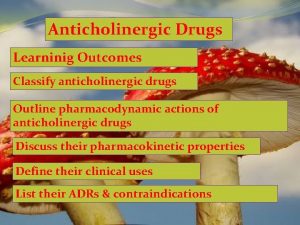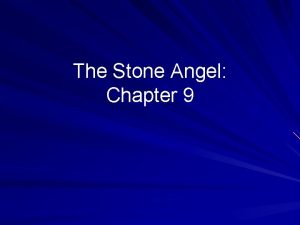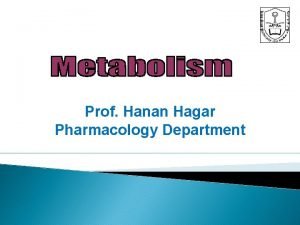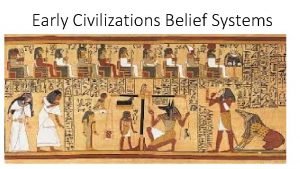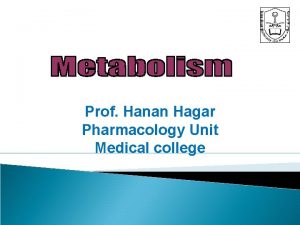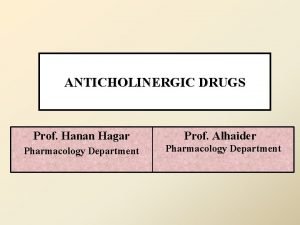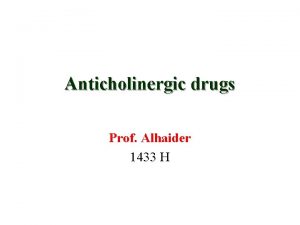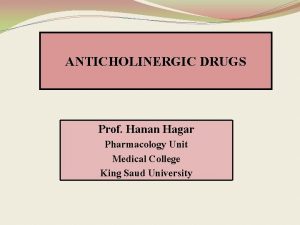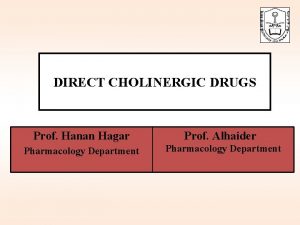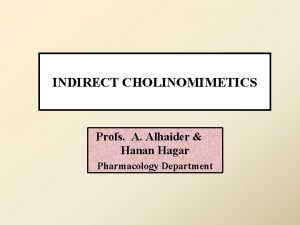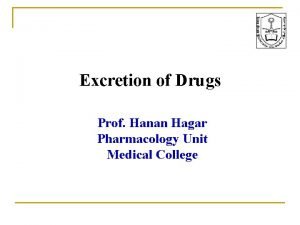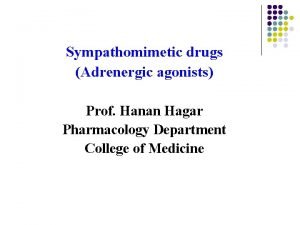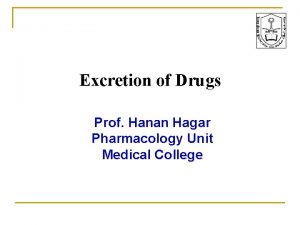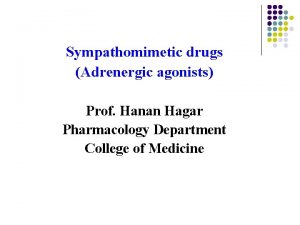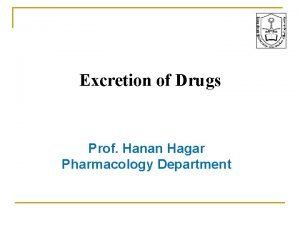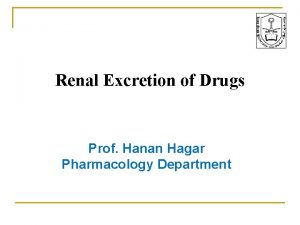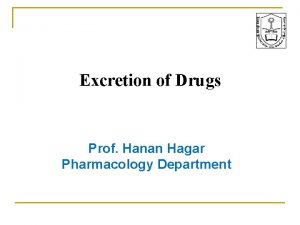ANTICHOLINERGIC DRUGS Prof Hanan Hagar Prof Alhaider Pharmacology




















- Slides: 20

ANTICHOLINERGIC DRUGS Prof. Hanan Hagar Prof. Alhaider Pharmacology Department

Anticholinergic drugs What students should know: Student should be able to : • Describe Kinetics of muscarinic antagonists • The effects of atropine on the major organ systems. • To list the clinical uses of muscarinic antagonists • To know adverse effects & contraindications of anticholinergic drugs. • To identify at least one antimuscarinic agent for each of the following special uses: mydriasis, cyclopedia, peptic ulcer & parkinsonism.

Anticholinergic drugs are drugs that block cholinergic receptors.

Anticholinergic drugs Antimuscarinics (Muscarinic antagonists) Antinicotinics Ganglionic blockers Naturally occurring alkaloids synthetic atropine substitutes Neuromuscular blockers

Muscarinic antagonists Natural alkaloids • Include drugs as • Atropine - Hyoscine • Esters of tropic acid and tertiary amines • Lipid soluble • Good oral absorption • Good distribution • Cross blood brain barrier (have CNS actions)

Synthetic Muscarinic antagonists Benztropine Homatropine Tropicamaide Pirenzepine Ipratropium Glycopyrrolate Oxybutynin

Mechanism of action of antimuscarinic drugs • Antimuscarinic drugs are competitive antagonists of the binding of ACh to muscarinic receptors.

Pharmacological effects of antimuscarinic drugs Eye q. Passive mydriasis (paralysis of circular muscle) q. Cycloplegia (loss of near accommodation) (paralysis of ciliary muscle) q. Loss of light reflex. q increase intraocular pressure (IOP) # glaucoma q Lacrimal secretion sandy eye Respiratory system q Bronchial relaxation (bronchodilation) q Bronchial secretion viscosity

Cardiovascular system (CVS) q Tachycardia (increase heart rate) q AV conduction (+ve dromotropic effect) q Toxic dose: cutaneous vasodilatation (flushing). Secretions ¯ salivary secretion (dry mouth). sweating dry skin fever in infants and children bronchial secretion viscosity ¯ lacrimal secretion sandy eye ¯ Gastric acid secretion

Gastrointestinal tract (GIT) – Gastric acid secretion – Relaxation of smooth muscles. – GIT motility Antispasmodic effect. – Sphincter contractions – Constipation Urinary Tract – Relaxation of smooth muscles of ureters. – Sphincter contraction. – Urinary retention.

Central Nervous System – Sedation – Antiemetic effect (block vomiting center) – antiparkinsonian effect (block basal ganglia). Large doses: can produce Hyperthermia - excitement-hallucination, coma

Hyoscine What is difference between atropine and hyoscine? Hyoscine has • Shorter duration of action • More CNS depressant action • Less CVS effect • Has antiemetic effect (used in motion sickness) • Can produce amnesia.

Muscarinic agonists Eye § Miosis Muscarinic antagonists § passive mydriasis (contraction of circular muscle) (relaxation of circular muscles) § near vision accommodation (contraction of ciliary muscles) Heart bradycardia Urinary bladder contraction of muscles relaxation of sphincter Increased urination § relaxation of ciliary muscles (Cycloplegia) loss of accomodation Tachycardia relaxation of muscles contraction of sphincter Urinary retention

Muscarinic agonists Exocrine glands ↑ Increase of sweat, saliva, lacrimal, bronchial, intestinal secretions GIT § ↑peristalsis § ↑secretion §relaxation of sphincter diarrhea Respiratory system § bronchoconstriction § ↑bronchial secretion Muscarinic antagonists ↓decrease all secretion dry skin, dry mouth, sandy eyes § ↓peristalsis § ↓secretion § contraction of sphincter constipation § bronchodilation § ↓decrease secretion

Uses of antimuscarinic drugs Ø Ø Ø Ø Fundus examination of eye Antiemetic in motion sickness Pre-anesthetic medication Antispasmodic Parkinson's disease Asthma Peptic ulcer Treatment of overdoses of cholinesterase inhibitors

Uses of antimuscarinic drugs Uses Drugs Atropine Pre-anesthetic medication Antispasmodic Hyoscine Antiemetic in motion sickness Pre-anesthetic medication antispasmodic Benztropine Parkinson's disease Homatropine Fundus examination of eye Ipratropium Asthma Chronic obstructive pulmonary disease(COPD) inhalation Telenzepine Peptic ulcer Glycopyyrolate Antispasmodics in hypermotility

Side effects of antimuscarinics Eye: blurred vision – mydriasis CVS: tachycardia - cutaneous flush (atropine flush) GUT: urinary retention GIT: constipation, paralytic ileus Secretions: dryness of mouth, sandy eye, hyperthermia CNS: hallucination, excitation (Toxic dose). Treatment of overdose of antimuscarinics – Gastric lavage. – Anticonvulsant. – Cooling blanket. – Antidote: Physostigmine (IV slowly).

Contraindications – – – Glaucoma (angle closure glaucoma) Tachycardia Prostate hypertrophy in old patients. Constipation, paralytic ileus. Children in case of atropine

Question Can antimuscarinic drugs reverse the action of Ach on skeletal muscles?

Thank you Questions ?
 Classification of anticholinergic drugs
Classification of anticholinergic drugs Anticholinergic drugs mechanism of action
Anticholinergic drugs mechanism of action Anticholinergic drugs
Anticholinergic drugs Anticholinergic vs antimuscarinic
Anticholinergic vs antimuscarinic Blocking muscarinic receptors would
Blocking muscarinic receptors would Classification of anticholinergic drugs
Classification of anticholinergic drugs Anticholinergics examples
Anticholinergics examples Emetrol mechanism of action
Emetrol mechanism of action What drugs are anticholinergic
What drugs are anticholinergic Sar of cholinergic agents
Sar of cholinergic agents Classify anticholinergic drugs
Classify anticholinergic drugs Anticholinergic
Anticholinergic Pharmacology of drugs acting on respiratory system
Pharmacology of drugs acting on respiratory system Adrenal drugs pharmacology
Adrenal drugs pharmacology Marvin hagar
Marvin hagar Define drug metabolism
Define drug metabolism A tirinha de hagar estabelece uma interessante contraponto
A tirinha de hagar estabelece uma interessante contraponto Hagar hamed rua
Hagar hamed rua Shiva pakistan
Shiva pakistan Smith
Smith Factors affecting drug metabolism
Factors affecting drug metabolism
